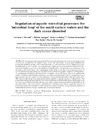Please use this identifier to cite or link to this item:
https://accedacris.ulpgc.es/jspui/handle/10553/72884
| DC Field | Value | Language |
|---|---|---|
| dc.contributor.author | Herndl, Gerhard J. | en_US |
| dc.contributor.author | Agogué, Hélène | en_US |
| dc.contributor.author | Baltar, Federico | en_US |
| dc.contributor.author | Reinthaler, Thomas | en_US |
| dc.contributor.author | Sintes, Eva | en_US |
| dc.contributor.author | Varela, Marta M. | en_US |
| dc.date.accessioned | 2020-06-02T13:31:01Z | - |
| dc.date.available | 2020-06-02T13:31:01Z | - |
| dc.date.issued | 2008 | en_US |
| dc.identifier.issn | 0948-3055 | en_US |
| dc.identifier.other | Scopus | - |
| dc.identifier.uri | https://accedacris.ulpgc.es/handle/10553/72884 | - |
| dc.description.abstract | Our understanding of microbial food web interactions in the ocean is essentially based on research performed in the euphotic layer, where the interactions between phytoplankton and prokaryotic plankton, mainly heterotrophic Bacteria, are well established. In the euphotic layer, particularly in meso- and eutrophic waters, prokaryotic plankton are mainly top-down controlled by bacterivorous flagellates and viruses, affecting metabolically active, fast growing populations more than dormant stages. In the meso- and bathypelagic realm of the ocean, however, prokaryotic plankton are thought to be mainly bottom-up controlled, because the heterotrophic component of the prokaryotic community is limited by the availability of organic carbon. However, deep-water prokaryotes exhibit a number of peculiarities compared to prokaryotes in the euphotic layer, among which are a large genome size and a gene repertoire indicative of a predominately surface-attached mode of life. This indicates that deep-water prokaryotic activity might be primarily associated with particles. Our present knowledge indicates that the microbial communities and their interactions in the deep ocean are likely very different from those known from surface waters. Increasing efforts to shed light on the microbial biota of the ocean's interior will likely lead to the discovery of novel metabolic pathways in prokaryotes and to the resolution of the current discrepancy between the geochemical evidence of remineralization rates of organic matter and actual measurements. | en_US |
| dc.language | eng | en_US |
| dc.relation.ispartof | Aquatic Microbial Ecology | en_US |
| dc.source | Aquatic Microbial Ecology [ISSN 0948-3055], v. 53 (1), p. 59-68, (Septiembre 2008) | en_US |
| dc.subject | 2414 Microbiología | en_US |
| dc.subject.other | Archaea | en_US |
| dc.subject.other | Bacteria | en_US |
| dc.subject.other | Bacterial Growth | en_US |
| dc.subject.other | Biogeography | en_US |
| dc.subject.other | Functional Diversity | en_US |
| dc.subject.other | Growth Yield | en_US |
| dc.subject.other | Prokaryotes | en_US |
| dc.subject.other | Virioplankton | en_US |
| dc.title | Regulation of aquatic microbial processes: The 'microbial loop' of the sunlit surface waters and the dark ocean dissected | en_US |
| dc.type | info:eu-repo/semantics/conferenceObject | en_US |
| dc.type | ConferenceObject | en_US |
| dc.relation.conference | Progress and Perspectives in Aquatic Microbial Ecology: Highlights of the SAME 10, Faro, Portugal, September 2007 | en_US |
| dc.identifier.doi | 10.3354/ame01225 | en_US |
| dc.identifier.scopus | 54549084679 | - |
| dc.contributor.authorscopusid | 7005513845 | - |
| dc.contributor.authorscopusid | 8881813100 | - |
| dc.contributor.authorscopusid | 23476314200 | - |
| dc.contributor.authorscopusid | 8368531200 | - |
| dc.contributor.authorscopusid | 15833225000 | - |
| dc.contributor.authorscopusid | 56269482300 | - |
| dc.description.lastpage | 68 | en_US |
| dc.identifier.issue | 1 | - |
| dc.description.firstpage | 59 | en_US |
| dc.relation.volume | 53 | en_US |
| dc.investigacion | Ciencias | en_US |
| dc.type2 | Actas de congresos | en_US |
| dc.utils.revision | Sí | en_US |
| dc.date.coverdate | Septiembre 2008 | en_US |
| dc.identifier.ulpgc | Sí | es |
| dc.description.jcr | 2,19 | |
| dc.description.jcrq | Q1 | |
| dc.description.scie | SCIE | |
| item.fulltext | Con texto completo | - |
| item.grantfulltext | open | - |
| Appears in Collections: | Actas de congresos | |
SCOPUSTM
Citations
39
checked on Jun 8, 2025
WEB OF SCIENCETM
Citations
37
checked on Jun 8, 2025
Page view(s)
97
checked on Jan 11, 2025
Download(s)
85
checked on Jan 11, 2025
Google ScholarTM
Check
Altmetric
Share
Export metadata
Items in accedaCRIS are protected by copyright, with all rights reserved, unless otherwise indicated.
